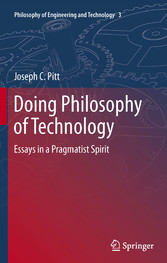Suchen und Finden
Introduction
7
Doing Philosophy of Technology
7
References
14
Contents
15
Part I Society, Ethics and Values
19
1 Human Beings as Technological Artifacts
20
1.1 John Dewey and the Aims of Education
21
1.2 The Design Process
22
1.3 Students as Self-Designers
23
1.4 Active Versus Passive, Redux
24
2 Technology and the Objectivity of Values
28
2.1 Introduction
28
2.2 Types of Judgments
30
2.3 Epistemic Values as Objective Values
31
2.4 Problems with Ethics
34
2.5 The Methodology of Technological Decision-Making
36
References
38
3 Anticipating the Unknown
39
3.1 Introduction
39
3.2 Pragmatism
40
3.3 Ethics
41
3.4 Philosophy and Pragmatism
43
3.5 The Law of Unintended Consequences (LUC)
45
3.6 Way of Going and the Good Life
46
3.7 Common Sense Pragmatism
47
3.8 Common Sense Pragmatism as an Ethical Theory
47
3.9 Common Sense Pragmatism, Ethics, and Nanotechnology
49
3.10 A Different Approach
50
References
54
4 Dont Talk to Me
55
Part II Methodological Issues
59
5 Against the Perennial
60
5.1 Continents
60
5.2 Tectonics
61
5.3 Meaning
64
References
68
6 Philosophical Methodology, Technologies, and the Transformation of Knowledge
69
6.1 Introduction
69
6.2 Whats Wrong with the Philosophy of Technology?
70
6.3 The Aim of Philosophy
70
6.4 Changing Knowledge
72
6.5 Galileo and Mathematics
74
6.6 Galileo and the Telescope
77
6.7 Space and Beyond
78
6.8 Standard Conditions
82
6.9 Conclusions
82
References
85
7 Working the Natural/Artificial Distinction
86
References
96
8 Discovery, Telescopes, and Progress
97
8.1 Introduction
97
8.2 Discovery
99
8.3 Definitions
100
8.4 Galileo and the Telescope
102
8.5 Sicilian Realism and Technological Infrastructures
105
References
106
9 Explaining Change in Science
107
References
113
10 The Dilemma of Case Studies
115
References
122
11 Technological Explanation
123
11.1 Relevance
124
11.2 Technological Versus Scientific Explanation
124
11.2.1 The DN Theory
125
11.2.2 Other Theories of Explanation
126
11.3 Questions and Internal and External Audiences
128
11.4 Terminology
129
11.5 Systems
129
11.5.1 System and Design
132
11.5.2 System and Function
133
11.5.3 System and Structure
133
11.6 The Social
135
11.7 Explaining Failures
136
11.7.1 The Challenger Example
137
11.7.2 The 2000 US Presidential Election Example
138
11.7.3 The Ladbroke Grove Railroad Crash Example
138
11.8 Conclusions and Objections
139
11.9 Failure, Success, and Symmetry
139
References
141
Part III Design and Engineering
143
12 Successful Design in Engineering and Architecture
144
12.1 Engineering Design
144
12.2 Architectural Design
146
12.3 The Role of Creativity
149
12.4 Creativity and Freedom
152
12.5 Engineering and Creativity
152
12.6 Conclusion: Architectural Failures and Successes
154
References
157
13 Design Criteria in Architecture
158
13.1 Introduction
158
13.2 Architectural Design and Philosophy of Technology
159
13.3 James and Common Sense
160
13.4 A Common Sense Proposal
161
13.5 Common Sense Design
163
13.6 Conclusion -- Graves Reconsidered and the Mystery of the Guggenheim Finally Solved
164
References
166
14 Philosophy, Engineering, and the Sciences
167
References
173
15 What Engineers Know
174
15.1 A Pragmatic Theory of Knowledge
175
15.2 Scientific Knowledge
175
15.3 Engineering Knowledge
177
15.4 Philosophical Problems
181
References
183
16 Design Mistakes
184
References
195
Part IV Nano
196
17 The Epistemology of the Very Small
197
17.1 Introduction
197
17.2 Seeing the Unobservable
197
17.3 The Role of Metaphor
198
17.4 Learning to See Through Microscopes
199
17.5 Learning to See with Electron Microscopes
201
17.6 The Nano Scale and Nano Technology
203
References
205
18 When Is an Image Not an Image?
206
References
213
19 Small Talk: Nanotechnology and Metaphor
214
19.1 Introduction
214
19.2 An Example of an Early Use of Metaphor to Facilitate Theory Change
215
19.3 NANO -- Do Mixed Metaphors and a Lot of Mathematics Constitute a Proof?
217
References
221
Index
222
Alle Preise verstehen sich inklusive der gesetzlichen MwSt.

















